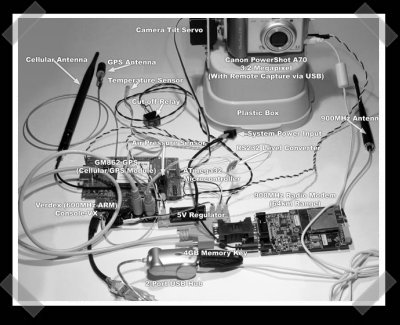
[Jock] sent in HALO, a nice diy high altitude recon project. Taking a page from the Kite Arial Photography guys, they mounted the camera on a servo tilt mechanism, had radio modem control and SMS gps position updates. I’m waiting for someone to put together a similar package that glides back to home base after the balloon is released.
By the way, if you’ve got a newer CRT RPTV, you might be interested how I fixed mine.















high altitude glider: http://www.hackaday.com/2005/01/12/homebrew-autonomous-high-altitude-glider/
I’d love to make something like this one day (be involved in the making of). Just so damned expensive.
regarding the rear projection tv, if the STK392 burns out routinely, it might be a good idea to tack a heat sink fan assembly from an old Pentium 1 board. there seems to be ample space from your image
“I’m waiting for someone to put together a similar package that glides back to home base after the balloon is released.”
Ask, and ye shall receive:
http://www.gpsboomerang.com/
GPS guided parachute capable of safely landing 15 tons of stuff:
http://paraflite.com/MegaFly%20Summary.htm
The ’05 high altitude glider was a neat project, but they didn’t release their embedded software, so nobody without a background in control theory was going to be able to completely reproduce their work. In ’08, there are a number of DIY autopilots available, including Paparazzi (http://paparazzi.enac.fr/wiki/index.php/main_page), and the R/C Pilot Project and (http://rcpilot.sourceforge.net/modules/rcap/index.php).
>I’d love to make something like this one day (be
>involved in the making of). Just so damned expensive.
Inexpensive? I did this about as cheaply as it can be done; see http://www.GeoCities.com/Almost_There_Weather_Balloon/
Good Luck!
Almost_There
almost_there looks very cool.
Wow. I read this a few days ago, and never thought to submit it. I read all sorts of things the day before they’re posted here. I should start remembering to submit things.
Anyway, natrium42 does cool work. He’s responsible for the original Nintendo DS passthrough device, as well as cool projects like this one (which produced very good pictures and video, by the way). Gotta love the ignorant “Alabama” man posting on the comments, too. Casting a dim image of America. Poor Canadians get enough shite from us.
Love his work, though.
A return-to-home Balloon/Glider project was done in 2001 (Wow – way ahead of their time!)
http://members.shaw.ca/sonde/index.htm
Here is another High Altitude Balloon Project built by my friend and we’re getting ready to launch this weekend (weather permitting) in the Dallas Area. No glider though!
Also, check out the http://www.DIYDrones.com site for tons of info on building you own UAV. The site is mostly about planes and helis, but there is a new blimp project there too. It sure keeps me busy :-)
Paul
Unfortunately, there are no (legal) opportunities to fly high altitude amateur UAVs in US airspace. The current and upcoming FAA regs require the device to be visible to the ground controller, and the ceiling limited to 400 feet AGL.
That’s too bad for me, since the sims I’ve run show that there’s no way to launch a weather balloon in Hawaii without the payload ending up in the drink. If I were on the mainland, I’d be looking at Mexico and Canada for launch sites.
It may be simpler to use a steerable parachute to let it glide to a desirable landing spot nearby. I’ve been pondering this for a while, the NASA lander’s parachute design is available, but I’m thinking more in the line of something much simpler.
This is some inspiring stuff! I would like to do something similar, but in the reverse direction, since I live near the sea. My idea was an autonomous sea drone connected by wireless internet and/or radio link, with an underwater ROV, and could be operated online.
I have some questions though. The ROV equipment should be at the same pressure than the outside water, so it would be immersed in a liquid. Any info about cameras and semiconductorâs behaviour regarding pressure? I can go as deep as 5 Km in the nearby area (60 nm) and that would be about 500 atm!